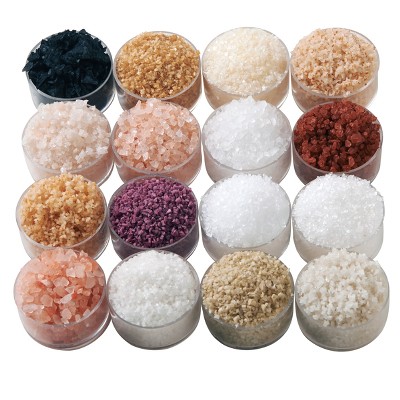Salt of the Earth

By: Epicurious Em QUOTE: “No cook is worth his salt unless he knows how to use it.” --UnknownNothing can make or break a meal quicker than salt, as proper seasoning is a basis of successful cooking. Too little salt will result in a bland dish, too much will be trying to your taste buds.
Kosher salt, sea salt, and table salt are typical cooking salts and are chemically identical to one another; however, they should be used for different cooking methods. Kosher salt is a staple in professional kitchens. It got its name because it is commonly used when preparing kosher meat. It has large, irregular shaped coarse crystals. It is mild in flavor and lacks additives. Table salt is the standard for most non-professional kitchens. The fine grains make it easy to dissolve, as in boiling salted water for pasta, brining, etc. In recent years, we’ve been inundated by the need to use “healthy” and fancy sea salts. The claim that sea salt has any sort of benefit over kosher and table salt is really unsubstantiated.
The more expensive artisanal salts that we have been seeing on the shelves of our supermarkets and gourmet food stores should be used more conservatively and expressly for the taste and flavor they will impart to a particular dish. Some of the more common are:
Sea Salt – is made using evaporated seawater. It is a lightweight, moisture-rich salt, which is a versatile and elegant finishing salt. Most are pricey based on origins from France, Sicily, Portugal, and Spain, (to name a few countries) and also the complexities associated with harvesting. Celtic sea salt is made using a 2000-year-old technique from the water of the Celtic Sea. Another type, fleur de sel (meaning flower of salt) is harvested mainly in the same region of France by manually scraping the top layer of the salt before it sinks to the bottom of a salt pan. It leaves both a subtle and a not-so-subtle effect on food, with a sea-like essence combining a pronounced crunch along with smaller bits to melt on your palate.
Himalayan Salt – is harvested in the foothills of the Himalayan mountain range. It is basically fossilized sea salt with a pink tint due to the amount of minerals, particularly iron.
Black Salt – also known as Kala Namak, has a pinkish/grey hue and is mined in India with a strong sulphuric smell. Vegan chefs use it for its “eggy” flavor.
Red and Black Hawaiian Sea Salts – are traditionally pretty coarse and give us a combination of volcanic and carbonic ocean salts. Both are traditional in Hawaiian cuisine, are pricey, but can even be used with a rich chocolate dessert.
TIP: The best place we have found in the playa area to purchase different types of salts is the Organica Store in the Coronado Village. My personal favorite for every day use is “Field Day Natural” Mediterranean Coarse Sea Salt. It is harvested on the coast of Spain and is kosher certified. It has great, clean flavor with a delicate crunch and to me is a bargain at $2.99 for 24.7 oz. (700 g).
Epicurious Em welcomes your comments and suggestions. The information in this article provides basic information only. It is always good to do your own research for what is best for your dietary and cooking needs. Feel free to e-mail me at em@playacommunity.com.
